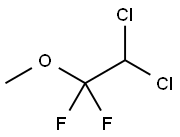76-38-0
中文名稱(chēng)
甲氧氟烷
英文名稱(chēng)
methoxyflurane
CAS
76-38-0
EINECS 編號(hào)
200-956-0
分子式
C3H4Cl2F2O
MDL 編號(hào)
MFCD00040144
分子量
164.97
MOL 文件
76-38-0.mol
更新日期
2024/12/16 08:57:49
 76-38-0 結(jié)構(gòu)式
76-38-0 結(jié)構(gòu)式
基本信息
中文別名
2,2-二氯-1,1-二氟-1-甲氧乙烷甲氧氟烷
甲氧氟乙烷
二氟二氯乙基甲醚
2,2-二氯-1,1-二氟乙基甲基醚
英文別名
2,2-DICHLORO-1,1-DIFLUOROETHYL METHYL ETHERMETHOXYFLURANE
METOFANE
1,1-dichloro-2,2-difluoro-2-methoxyethane
2,2-dichloro-1,1-difluoro-1-methoxy-ethan
2,2-Dichloro-1,1-difluoro-1-methoxyethane
2-methoxyethane,1,1-dichloro-2,2-difluoro-
Analgizer
Anecotan
DA-759
Ethane, 2,2-dichloro-1,1-difluoro-1-methoxy-
Ether, 2,2-dichloro-1,1-difluoroethyl methyl
ether,2,2-dichloro-1,1-difluoroethylmethyl
Ingalan
Inhalan
Methofane
Methoflurane
Methoxane
Methoxiflurane
Methoxyfluoran
所屬類(lèi)別
原料藥:全身麻醉劑物理化學(xué)性質(zhì)
外觀性狀無(wú)色易流動(dòng)的透明液體。熔點(diǎn)-35℃,沸點(diǎn)105℃,(13.3kPa),相對(duì)密度(20/4℃)1.4262,折光率(nD20)1.3861。有水果香味。
熔點(diǎn)-36°C
沸點(diǎn)103 °C
密度1.4262
折射率1.386
閃點(diǎn)37°C
儲(chǔ)存條件-70°C
溶解度Chloroform (Sparingly)
形態(tài)liquid
顏色Clear
水溶解性Miscible with alcohol, acetone, chloroform, ether, fixed oils and benzene. Immiscible with water.
Merck14,5994
BRN1737766
暴露限值No exposure limit is set. Based on comparison with related compounds, a TLV-TWA
of 675 mg/m3 (100 ppm) is recommended.
穩(wěn)定性Stability
CAS 數(shù)據(jù)庫(kù)76-38-0(CAS DataBase Reference)
EPA化學(xué)物質(zhì)信息Methoxyflurane (76-38-0)
安全數(shù)據(jù)
警示詞警告
危險(xiǎn)性描述H226-H319-H341
防范說(shuō)明P210-P241-P308+P311
危險(xiǎn)品標(biāo)志Xi
危險(xiǎn)類(lèi)別碼R10
安全說(shuō)明S23-S24/25
危險(xiǎn)品運(yùn)輸編號(hào)3271
RTECS號(hào)KN7820000
Hazard NoteIrritant
危險(xiǎn)等級(jí)3
包裝類(lèi)別III
海關(guān)編碼2909191800
毒害物質(zhì)數(shù)據(jù)76-38-0(Hazardous Substances Data)
毒性One of the most potent of the inhalational anesthetics, having
a very high blood-gas partition coefficient and low vapor pressure
at room temperature. Methoxyflurane is metabolized to a
great extent (about 50-70%) in the liver and, as a consequence,
there may be release of high concentrations of fluoride, sufficient
to exceed the threshold for renal damage. Its use for sustained
anesthesia is limited because of this renal toxicity and was discontinued
around 1980.

